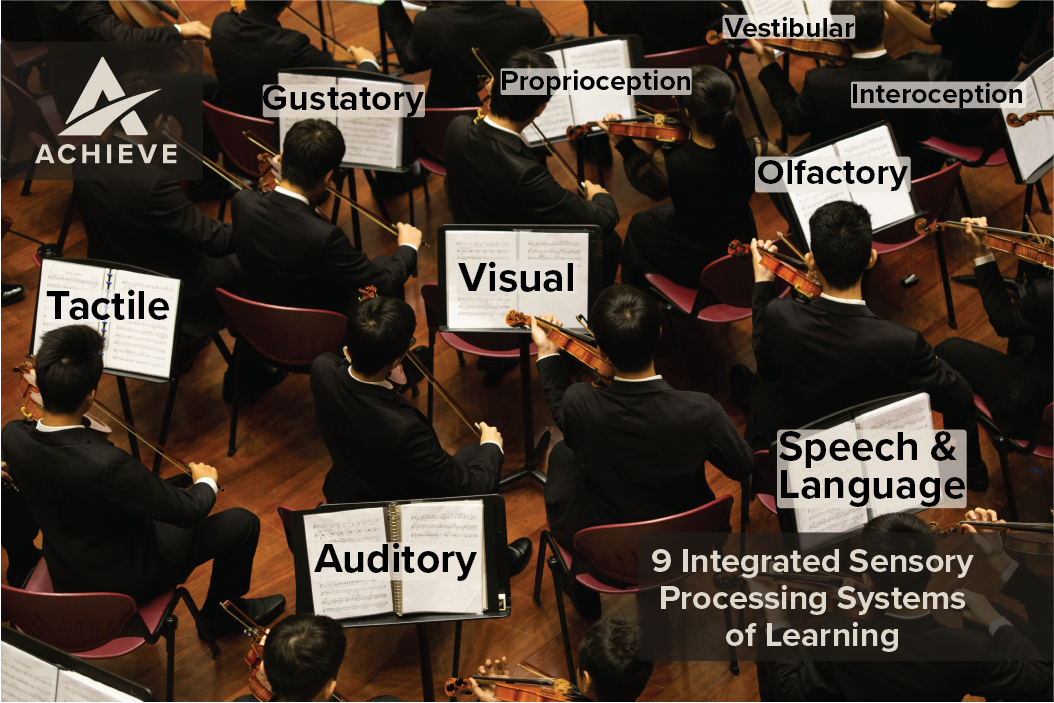Learning: A Symphony of Sensory Processing
We learn as we process the world around us through nine primary sensory systems. They are:
Visual (vision)
Auditory (hearing)
Speech/Language (communication)
Tactile (touch)
Olfactory (smell)
Gustatory (taste)
Vestibular (balance)
Proprioception (our body’s relationship to its surroundings)
Interoception (the feeling of safety/security from within)
We connect the stimuli these systems provide to our brains with our memories of past experiences provided by these same sensory processing systems, giving us a framework within which to understand new information or, in other words, to learn.
Learning is supported by the effective integration of and communication between these nine systems. In concert, they create our cognitive experiences. When any of these systems send conflicting information to the brain, sensory interference causes disruption to the learning process, which can manifest as confusion, insecurity, discomfort, pain, avoidance, or other detractors to effective learning. Beyond hindering our learning, these effects can lead to behavioral challenges and/or mental health struggles – especially in children and teenagers.
Our Sensory Symphony Orchestra
Think of these nine sensory systems as the instruments in a symphony orchestra. When they are working in harmony with each other, the results are beautiful and productive. When one instrument is out of tune, plays the wrong notes, or isn’t in time with the rest, the result is discord.
This is true when one of these processing systems isn’t fully functioning or isn’t in sync with the others. Just like unpleasant music from a poorly performing orchestra, a person experiencing discord among these systems experiences the symptoms we mentioned a moment ago. These feelings disrupt the entire learning process as the brain struggles to pay attention to the rest of the information being presented through the other systems while trying to compensate for the malfunctioning system. This creates a mildly to painfully difficult learning experience for the person experiencing this discord.
Well-meaning, Misinformed Labels and Conclusions
Without holistically understanding what is going on in the brains of children living such experiences, we may label them as Dyslexic, lazy, learning disabled, having ADHD, and so on. These labels are commonly used to describe observed behaviors or learning challenges when a professional, educator, or parent can clearly hear that the “music of learning” is considerably out of tune but cannot clearly identify which member of the sensory orchestra is the culprit. Identifying the root cause(s) of a child’s challenges with reading, writing, spelling, or other facets of learning is often difficult because the sensory processing systems are so intertwined in the learning process.
Misinformation and misconceptions make it easy to jump to conclusions as we try to understand and help children who are doing their best, yet clearly struggling. We research help online and seek out tutors, specialists, and diagnoses in an effort to find solutions. We meet with our children’s teachers and schools to put together IEPs or 504 Plans to provide support and accommodations to help our children while we continue our search for answers.
“But I Know My Child Is Intelligent!”
As parents, we know our children better than anyone. We can see that they are bright and intelligent, even though they seem to struggle specifically with reading, writing, or spelling. We may be tempted to tell our children to try harder, read more, or stop getting distracted and just pay better attention in class. When children’s struggles are rooted in a disruption to one or more of their sensory processing systems, however, then all the reading practice or extra homework in the world will only bring on frustration and overwhelm, and ingrain already-existing poor patterns of processing.
So, What Is a Parent to Do?
We can choose to continue to accommodate our children’s situations the best we can in order to help them deal with their reading and learning challenges (which puts the challenge in control and us and our children on the defensive), OR we can identify the core sensory learning challenges and proactively address them at their source (putting us and our children in control) so our children can overcome the obstacles that are keeping them from reading and learning at their full potential.
To this end, ACHIEVE offers an extensive, integrated Dyslexia & Sensory Processing Evaluation that identifies core processing issues and illuminates solutions that address them effectively and sustainably.
This 90-minute evaluation is administered by a specially trained evaluation aide whose findings are subsequently reviewed by a panel of doctors and other healthcare professionals, then followed up within a few days with a private, doctor-led parent conference to explain the findings, make recommendations, and provide a treatment plan that, when needed, involves coordinated providers across different practices and specialties. It’s the first comprehensive solution of its kind in the world.
You’ve played the “case worker” and investigator roles for your child’s struggles long enough. When you’re ready to bring our integrated team of professionals who understand what you are facing into your corner and relieve you of the frustrations of your ongoing search for answers, just ask us. We’re ready when you are.
To schedule your child’s Dyslexia & Sensory Processing Evaluation, simply call our office at 801-492-6393. We look forward to serving your child – and you.
To your child’s ongoing success,
Dr. Mark Curtis, OD, FCOVD
Dr. Jeremy Gardner, OD, FAAO
Dr. Christopher Pope, OD





